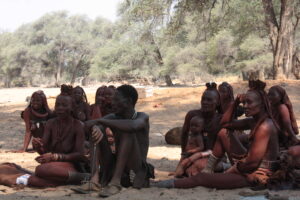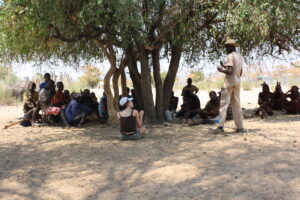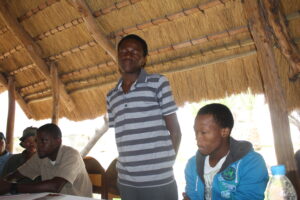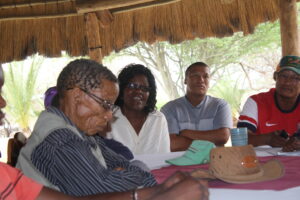Engaged Anthropology Grant: Ashley Hazel and “Communicating Disease: The Patterns of Sexually Transmitted Disease Burden Among Namibian Pastoralists and Why It Matters”

Dr. Ashley Hazel is a postdoctoral researcher in anthropology at Stanford University. In 2008, while a Ph.D. student at the University of Michigan, she received a Dissertation Fieldwork Grant to aid research on ‘Sexually Transmitted Disease, Ecology, and Reproduction among the Tjimba/Himba: A Pastoral Community in Transition,’ supervised by Dr. Bobbi Stiers Low. Following her fieldwork research seeking to measure the prevalence of two common STDs—gonorrhea and herpes—and identify significant ecological and behavioral risk factors for disease in her host community, she received Wenner-Gren’s Engaged Anthropology Grant to return to her field site and share her findings.
My PhD research sought to measure the prevalence and risk factors of two common sexually transmitted diseases (STDs)—herpes simplex virus type 2 (herpes) and Neisseria gonorrhea (gonorrhea)—among the highly remote pastoralists of Kaokoland, in northwestern Namibia. This community has long been considered high-risk for two reasons: First, it is generally acceptable for men and women to have multiple and concurrent sexual partners and, meanwhile, condoms are generally disliked and distrusted. Second, Kaokoland is a highly remote and resource-poor area of Namibia where access to healthcare and health education is unreliable at best. To learn about the degree and sources of burden of STDs in Kaokoland, I had to collect highly sensitive data and make requests from the study participants that were completely unheard of. Among other things, I asked people to collect a swab of genital fluid (to test for gonorrhea), to let me prick their finger for a small blood sample (to test for herpes), and to tell me the names of all their current sexual partners. These are very strange, possibly frightening, requests, and yet, 445 people trusted me when I said I was asking for these samples and personal details because the information gleaned from them could have a positive impact on reproductive health for their community. It was the generous and trusting spirits of these participants that motivated my application to the Engaged Anthropology Grant Program. I felt a debt to their contribution that could not be paid solely through dissemination in academic journals and conferences.

Therefore, I proposed to return to Namibia with the primary aim of communicating my research findings to community members in Kaokoland, local healthcare workers, and policy-makers at the Ministry of Health and Social Services (MoHSS). I had an additional, indirectly related, aim to engage in conversations with advanced secondary and early tertiary Namibian students to promote more Namibians to conduct social science research in their country. My trip to Namibia was full and productive; I feel that I accomplished most aspects of my aims, though not always in the way I expected to.
Sharing my research findings
Although I have been to Namibia two other times since completing my fieldwork in 2009, this dissemination trip was to be my first return to the villages where I collected data. After arriving in Namibia, I traveled up to Kaokoland and began a series of trips to some of the main villages where we collected data in 2009. As it is the dry season in Kaokoland (during a drought year, no less) people are more dispersed and villages that are small to begin with clear out completely. We therefore focused on the larger villages where we could gather groups of at least ten people.

To my great delight and relief, we (my translator, John, and me) were welcomed back warmly to each village and we gathered large groups for our meetings. I began the meetings be reminding people about the purpose of my research and the kinds of data I was collecting. Although I always recognized several people at our gatherings, there were many people whom I had not met and might not have heard of our work. For each meeting, I summarized the key points of my findings and, with each finding, I explained why I thought it was important information for healthcare workers to know about. For example, I explained that the majority of high bacteria-load gonorrhea cases in the study sample came from people staying in villages in the Ehama region during the winter months for the plethora of weddings and ceremonies taking place there during the winter months. I told them that I thought this is information that could be useful for the resource-strapped local clinics to target their outreach efforts at times and places where risk is highest.
Our meetings usually began to take on a discussion format when I brought up the issue of asymptomatic infections. I was alarmed at the number of gonorrhea cases in my sample that were asymptomatic (i.e. the participant’s sample was positive, but the participant reported no symptoms of infection within the past six months). Given the remoteness of Kaokoland, STDs are managed syndromically, so if an infected person does not recognize his or her symptoms, they will not receive treatment. Although there could be biological explanations for this phenomenon—the majority of gonorrhea strains circulating through Kaokoland do not produce symptoms or these asymptomatic cases reveal partial immunity to common strains—there are likely also social factors. I offered the various village groups my best explanation for why infected people in Kaokoland do not recognize their symptom: there are heavy tradeoffs to visiting a clinic in the form of great time and money expenditure. If people often decide their symptoms do not warrant medical treatment, they will experience symptoms longer and those sensations—burning, itching, back/abdomen pain—will begin to feel normal, making it hard to identify true signs of infection. In general, people agreed that this explanation made sense, but in every village, people offered other explanations or stories for the disconnect among infection, symptoms, and treatment. In some cases, people acknowledged that when they experience gonorrhea-like symptoms they choose to wait several days to see if it will go away. (Such a strategy might be OK for some fevers or diarrhea, but with gonorrhea, the disappearance of symptoms is not coincident with the disappearance of infection.) In one village, people told me that if their symptoms do not include observable discharge (which is common, especially for women), the nurse will not give them medication. These discussions were very enlightening for me because they gave me a much truer and more complex picture of the healthcare challenges in Kaokoland. These discussions helped shape what I thought would be my talking points when I had my meetings at the MoHSS, the week after leaving Kaokoland.

I met with several people at the Ministry of Health. My most valuable discussions were with Dr. Ismael Katjitae, an internal medicine specialist who works closely with AIDS treatment guidelines and who has long been enthusiastic about health research in Namibia. We spoke at length about my findings and the challenges of syndromic management programs, particularly with regard to the social pressures that influence treatment-seeking behavior. Dr. Katjitae also introduced me to a few colleagues of his that are interested in reproductive healthcare and STD research. These introductions have developed into ongoing conversations where we exchange information about the challenges of providing rural healthcare and how to design health research for highly remote settings. Dr. Vaiya Zaetije has done outreach work in several rural areas of Namibia, including Kaokoland, and provided many new insights into the health problems of remotely living Namibians. He is also interested in expanding his outreach efforts to include research into common, but often undiagnosed, conditions in undertreated, rural communities; thus, we have begun discussion possible future collaborations that could merge my fieldwork expertise with his clinical outreach capabilities.
Promoting advanced education in Namibia
My second aim for my dissemination trip was to speak about careers in social science with TUCSIN students, who are advanced secondary students preparing to apply for university-level training. My work with TUCSIN on this trip was very fruitful, though I did not do the specific thing I proposed. At the time of my visit, Dr. Beatrice Sandelowsky, the TUCSIN founder who was to facilitate my lecture series at the four TUCSIN campuses, was engaged in negotiations to build a new campus in, Tsumkwe, in eastern Namibia. Tsumkwe is a small, remote town in the traditional home range of the Ju/’hoansi San people (aka, The Bushmen). It is one of the poorest areas of Namibia and the dropout rate for students, by the time they reach grade 12, is nearly 100%. Dr. Sandelowsky and TUCSIN see a great need for new educational resources in Tsumkwe, but are not sure where to start. Dr. Sandelowsky asked me to serve as a consultant on a trip to Tsumkwe wherein we would meet with local principals, teachers, tribal authorities, and other interested community members to determine the greatest educational needs for the community. We had several individual meetings with school staff and community workers and we also organized a large stakeholders meeting that brought together people with a range of background and perspectives. Our final assessment was that vocational training, adult education, and literacy training are in great need and will contribute to a system that supports advancement to secondary education and improves outcomes for individuals that do not complete high school. Meanwhile, Dr. Sandelowsky and I also discussed implementing a research-mentoring component to TUCSIN’s education work in Tsumkwe. We are now planning a program where we will work with former TUCSIN students (from the other campuses who have completed high school) and other Namibian undergraduate students to teach research skills (research design, field methods, analyses for social research) and culture and heritage preservation at the Tsumkwe campus.